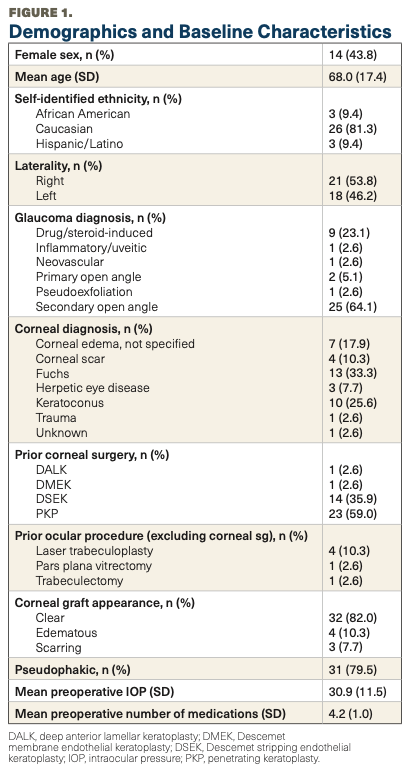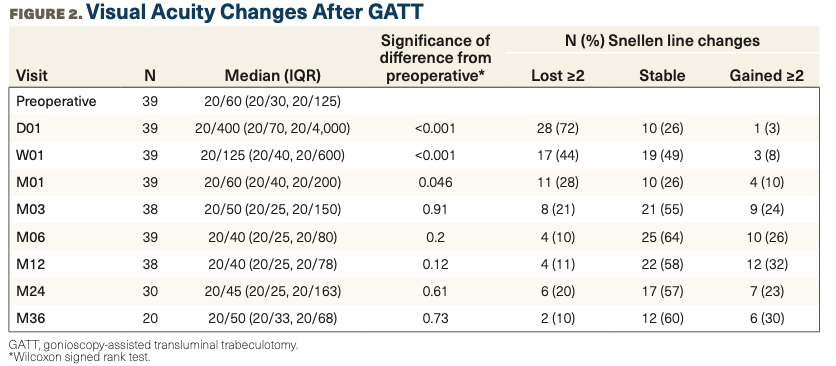Publication
Article
Gonioscopy-assisted transluminal trabeculotomy offers relief for patients undergoing corneal transplant
Author(s):
Key Takeaways
- GATT effectively reduces intraocular pressure and medication burden in post-corneal transplant glaucoma patients.
- The procedure involves micro-incisions and unroofing Schlemm's canal, offering a hardware-free alternative to traditional surgeries.
Approach to lowering IOP reduces medication burden without risking graft rejection.
(Image Credit: AdobeStock/Raymond Orton)

Reviewed by Oluwatosin U. Smith, MD
Glaucoma is a leading cause of vision loss worldwide, and the risk of developing glaucoma is known to be higher for patients undergoing corneal transplant. To lower intraocular pressure (IOP) following corneal surgery, gonioscopy-assisted transluminal trabeculotomy (GATT) can be a safe and effective alternative to traditional procedures.
The GATT procedure is performed via micro-incisions in the cornea. An incision approximately 1.0 mm in size is made in the periphery of the cornea through which the surgery is completed. After entering the eye, the surgical procedure involves cutting through the trabecular meshwork, cannulating Schlemm’s canal 360°, and unroofing Schlemm's canal.
A retrospective analysis of patients who underwent GATT following prior corneal transplant produced data to support GATT’s efficacy.1 Oluwatosin Smith, MD, a physician at Glaucoma Associates of Texas, Dallas, and the study’s lead author, discussed GATT as a safe and efficient intervention.
A reduction in medication burden is significant for patients post corneal transplant, such as some participants who began the study while on 4 or more medications.
Study cohort demographics

The case series documented a group of 32 patients and 39 eyes, all patients with glaucoma and a history of prior corneal surgery (Figure 1). The authors recognized this as the largest group with those characteristics to undergo clinical review thus far.1 Patient age ranged from 24 to 94 years (mean 68.0 y); 44% of participants were female and 81% were Caucasian. Prior corneal surgical procedures included penetrating keratoplasty (59.0%), Descemet stripping endothelial keratoplasty (35.9%), Descemet membrane endothelial keratoplasty (2.6%), and deep anterior lamellar keratoplasty (2.6%). In most cases, GATT was performed as a standalone procedure. In one instance it was performed in combination with cataract extraction/intraocular lens insertion; in another, GATT was performed alongside goniosynechialysis. All GATT procedures were performed by physicians at Glaucoma Associates of Texas between January 2016 and December 2019.
Among the study cohort, 35 patients (89.7%) had 1 prior corneal surgery while 4 patients (10.3%) had multiple corneal surgeries (range, 2-7).1 Secondary open-angle glaucoma was the most common (64.1%), followed by steroid-induced glaucoma (23.1%). Notably, patients with secondary open-angle glaucoma did not have preexisting glaucoma before their corneal transplants. At the 24-month visit, 20 eyes (51.3%) had completed follow-up data.
GATT following corneal surgery
Smith said that treating elevated IOP in eyes with glaucoma after corneal transplantation surgery is challenging, since surgeons must minimize potential insult to the corneal graft tissue. Following GATT, most patients saw a significant reduction in IOP, as well as reduced medication burden, at all postoperative time points (Figure 2). The study’s authors censored patients who required reoperation to control IOP (P<.001) from these figures, produced at the 24-month visit: at 24 months, IOP decreased from baseline of 30.9±11.5 to 13.9±4.7 mm Hg. Medications decreased from 4.2±1.0 medications at baseline to 0.6±1.0, and 88% of patients who completed the study remained on chronic topical steroids for graft maintenance.1
Afterward, 69% of eyes had at least 1 early complication. Postoperative complications noted at week 1 included hyphema (59%), corneal edema (18%), and vitreous prolapse (1%). At month 1, 77% had no complications, 13% reported persistent hyphema, and 10% (4 eyes) reported corneal edema. Between 3 and 9 months, 75% of eyes with cornea edema resolved; the 1 eye with persistent edema had corneal edema before GATT surgery.

After undergoing GATT, 7 eyes required reoperation for uncontrolled glaucoma at a median of 8.5 months (range, 1.6-16.2). The cumulative proportion of eyes requiring further surgery to control IOP was 10.3% (95% CI, 80%-99%) at month 12, increasing to 20.3% (95% CI, 67%-94%) at 24 months following GATT.
A month after surgery, visual acuity decreased in all eyes (all P< .05); but the authors stated “these recovered at subsequent follow-up visits with 2-Snellen line improvements exceeding losses from month 3 to 36.”1 Among the 4 eyes with visual decrease from baseline at 12 months, 2 eyes deteriorated from wet AMD with clear corneas, and 1 eye had a tube shunt with corneal decompensation and inflammation.
Given the safety and efficacy results of the GATT procedure in patients post corneal transplant, Smith reiterated the surgery as a suitable alternative for patients who have developed glaucoma following transplantation. GATT is especially prudent when applied in earlier stages of glaucoma development, she said, as part of an interventional approach.
“There are patients who this is optimal for, usually people who don’t have a secondary angle closure,” Smith said. “The reasons for their elevation in pressure could be related to prior surgery or having had a corneal transplant.”
Smith added physicians should take note of GATT, in particular, when a drainage device may pose risk to transplanted tissue.
“The benefit of having surgery without hardware in the eye is that you’re not leaving anything in the eye,” she said. “In the event that you have a drainage implant, because it’s a foreign body, there’s a risk of graft failure, exposure of the implant device and possible complications of an infection.”
“For patients who have open-angle glaucoma, we have to look at the risks vs benefits of doing a more traditional surgery,” Smith concluded. “When you have an option where the risks are low and the benefits are great, then comparing the procedures encourages you to go ahead and consider GATT as an option.”
Oluwatosin U. Smith, MD
P: 214-360-0000
E: tsmith@glaucomaassociates.com
Smith is an attending clinician and surgeon at
Glaucoma Associates of Texas and a founding board member of the Cure Glaucoma Foundation.
Reference:
1. Smith OU, Butler MR, Grover DS, et al.
Twenty-four-month outcome of honioscopy-
assisted transluminal trabeculotomy (GATT) in eyes with prior corneal transplant surgery. J Glaucoma. 2022;31(1):54-59. doi: 10.1097/IJG.0000000000001949
Newsletter
Don’t miss out—get Ophthalmology Times updates on the latest clinical advancements and expert interviews, straight to your inbox.




